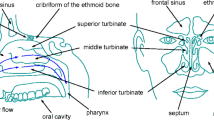Abstract
Modern nasal surgery aims at improving airways for healthy, comfortable breathing. Presently available measurements are not sufficient to describe optimized shapes, particle transport and flow. Computational Fluid Dynamics (CFD), particularly Large Eddy simulation (LES), might help to understand flow details and define standards. However, the human nose flow is challenging state-of-the-art CFD methods. It is generally not as clear and as well investigated as technical flows where CFD has originally been developed for. The challenging aspects are: First, the geometrical complexity of the nasal airways is much higher. Thin, long channels exist with multiple junctions and separations, 3-dimensionally contorted, requiring high resolution. Second, flow conditions are an interaction of several physical phenomena and tend to challenge numerical schemes in terms of viscosity, Reynolds number, Mach number, wall roughness, turbulence, heat transfer, humidity, fluid-tissue interaction etc. Third, only few validable experimental data of sufficient accuracy are available. Dealing with humans, either no standardized measurement conditions exist due to the bodies’ uniqueness or standard measurement procedures of engineering type cannot be applied. This causes a lack of comparability, limiting conclusions for surgery. Within this contribution, exemplary flow simulations through a real nose geometry under average conditions will be shown using a MPICH-parallelized, compressible Navier–Stokes scheme. The emphasis is on investigating fast, small-scale flow fluctuations near the regio olfactoria. The intention is to present a first step and to show in which direction developments must turn in order to perform reliable simulations. A 3D compressible CFD research code will be used, which is developed at the Institute of Fluid Machinery, University of Karlsruhe, Germany.
Access this chapter
Tax calculation will be finalised at checkout
Purchases are for personal use only
Preview
Unable to display preview. Download preview PDF.
Similar content being viewed by others
References
J. H. Ferziger and M. Perić. Computational Methods for Fluid Dynamics. Springer Berlin, 2002.
A. Gerndt, T. van Reimersdahl, T. Kuhlen, C. Bischof, I. Hörschler, M. Meinke, and W. Schröder. Large-Scale CFD Data Handling in a VR-Based Otorhinilaryngological CAS-System using a Linux-Cluster. Journal of Supercomputing, 25:143–154, 2003.
F. F. Grinstein and C. Fureby. From Canonical to Complex Flows: Recent Progress on Monotonically Integrated LES. Journal of Computing in Science and Engineering, 6:36–49, 2004.
E. J. Haberland, I. Pantle, S. Knipping, M. Knoergen, K. Stock, and K. Neumann. Anwendung von Large-Eddy-Simulation auf die Luftströmung in einem aus CT-Daten generierten nasalen Strömungsraum. In 79. Jahrestagung der Deutschen Gesellschaft für Hals-Nasen-Ohren-Heilkunde, Kopf- und Halschirurgie, Bonn, Germany, 2008. http://www.egms.de/en/meetings/hnod2008/08hnod573.shtml.
F. Magagnato. KAPPA - Karlsruhe Parallel Program for Aerodynamics. TASK Quarterly - Scientific Bulletin of Academic Computer Centre in Gdansk, 2(2):215–270, 1998.
I. Pantle, U. Serra, and M. Gabi. Flow and Acoustic Calculations in a Human Nose. In 8{th} International Symposium on Experimental and Computational Aerothermodynamics of Internal Flows (ISAIF8), Lyon, France, 2007.
K. I. Park, C. Brückner, and W. Limberg. Experimental study of velocity fields in a model of human nasal cavity by DPIV. In B. Ruck et al., editor, Proceedings 7 th International Conference on Laser Anemometry, Advances and Applications, Karlsruhe, Germany, pages 617–626, 1997.
F. Rieg. Z88 - Das kompakte Finite Elemente System, Version 12.0. http://www.z88.de/, 2006.
I. Weinhold and G. Mlynski. Numerical simulation of airflow in the human nose. European Archives of Oto-Rhino-Laryngology, 261(8):452–455, 2004.
Author information
Authors and Affiliations
Corresponding author
Editor information
Editors and Affiliations
Rights and permissions
Copyright information
© 2012 Springer-Verlag Berlin Heidelberg
About this paper
Cite this paper
Pantle, I., Gabi, M. (2012). Application of High Performance Computational Fluid Dynamics to Nose Flow. In: Bock, H., Hoang, X., Rannacher, R., Schlöder, J. (eds) Modeling, Simulation and Optimization of Complex Processes. Springer, Berlin, Heidelberg. https://doi.org/10.1007/978-3-642-25707-0_19
Download citation
DOI: https://doi.org/10.1007/978-3-642-25707-0_19
Published:
Publisher Name: Springer, Berlin, Heidelberg
Print ISBN: 978-3-642-25706-3
Online ISBN: 978-3-642-25707-0
eBook Packages: Mathematics and StatisticsMathematics and Statistics (R0)




